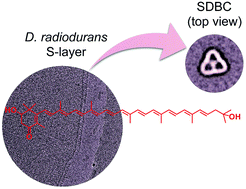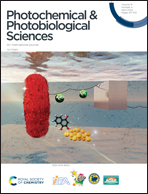Photophysics of deinoxanthin, the keto-carotenoid bound to the main S-layer unit of Deinococcus radiodurans†
Abstract
The keto-carotenoid deinoxanthin, which occurs in the UV-resistant bacterium Deinococcus radiodurans, has been investigated by ultrafast time-resolved spectroscopy techniques. We have explored the excited-state properties of deinoxanthin in solution and bound to the S-layer Deinoxanthin Binding Complex (SDBC), a protein complex important for UV resistance and thermostability of the organism. Binding of deinoxanthin to SDBC shifts the absorption spectrum to longer wavelengths, but excited-state dynamics remain unaffected. The lifetime of the lowest excited state (S1) of isolated deinoxanthin in methanol is 2.1 ps. When bound to SDBC, the S1 lifetime is 2.4 ps, indicating essentially no alteration of the effective conjugation length upon binding. Moreover, our data show that the conformational disorder in both ground and excited states is the same for deinoxanthin in methanol and bound to SDBC. Our results thus suggest a rather loosely bound carotenoid in SDBC, making it very distinct from other carotenoid-binding proteins such as Orange Carotenoid Protein (OCP) or crustacyanin, both of which significantly restrain the carotenoid at the binding site. Three deinoxanthin analogs were found to bind the SDBC, suggesting a non-selective binding site of deinoxanthin in SDBC.

- This article is part of the themed collection: The World Congress on Light and Life, Barcelona 2019


 Please wait while we load your content...
Please wait while we load your content...